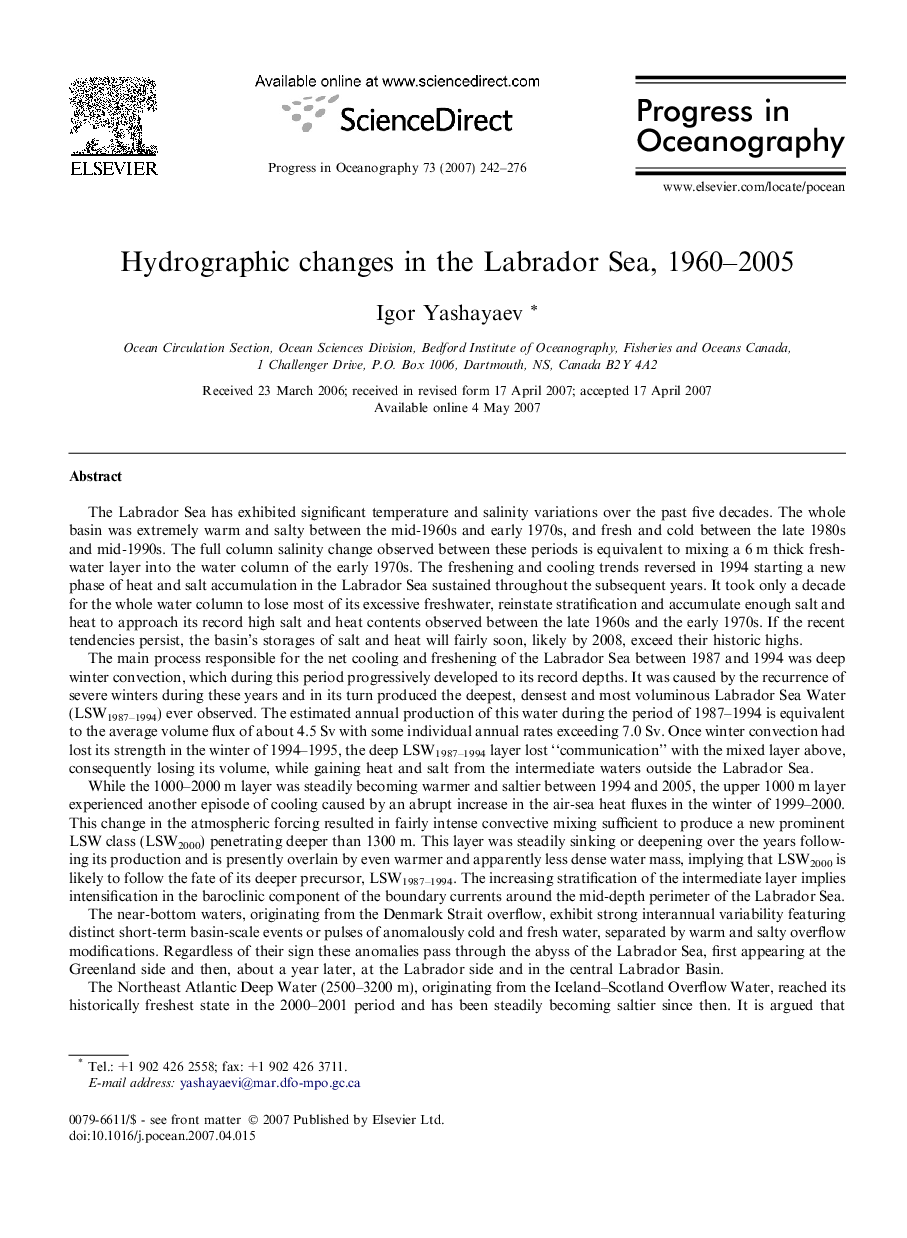| کد مقاله | کد نشریه | سال انتشار | مقاله انگلیسی | نسخه تمام متن |
|---|---|---|---|---|
| 4553854 | 1627972 | 2007 | 35 صفحه PDF | دانلود رایگان |

The Labrador Sea has exhibited significant temperature and salinity variations over the past five decades. The whole basin was extremely warm and salty between the mid-1960s and early 1970s, and fresh and cold between the late 1980s and mid-1990s. The full column salinity change observed between these periods is equivalent to mixing a 6 m thick freshwater layer into the water column of the early 1970s. The freshening and cooling trends reversed in 1994 starting a new phase of heat and salt accumulation in the Labrador Sea sustained throughout the subsequent years. It took only a decade for the whole water column to lose most of its excessive freshwater, reinstate stratification and accumulate enough salt and heat to approach its record high salt and heat contents observed between the late 1960s and the early 1970s. If the recent tendencies persist, the basin’s storages of salt and heat will fairly soon, likely by 2008, exceed their historic highs.The main process responsible for the net cooling and freshening of the Labrador Sea between 1987 and 1994 was deep winter convection, which during this period progressively developed to its record depths. It was caused by the recurrence of severe winters during these years and in its turn produced the deepest, densest and most voluminous Labrador Sea Water (LSW1987–1994) ever observed. The estimated annual production of this water during the period of 1987–1994 is equivalent to the average volume flux of about 4.5 Sv with some individual annual rates exceeding 7.0 Sv. Once winter convection had lost its strength in the winter of 1994–1995, the deep LSW1987–1994 layer lost “communication” with the mixed layer above, consequently losing its volume, while gaining heat and salt from the intermediate waters outside the Labrador Sea.While the 1000–2000 m layer was steadily becoming warmer and saltier between 1994 and 2005, the upper 1000 m layer experienced another episode of cooling caused by an abrupt increase in the air-sea heat fluxes in the winter of 1999–2000. This change in the atmospheric forcing resulted in fairly intense convective mixing sufficient to produce a new prominent LSW class (LSW2000) penetrating deeper than 1300 m. This layer was steadily sinking or deepening over the years following its production and is presently overlain by even warmer and apparently less dense water mass, implying that LSW2000 is likely to follow the fate of its deeper precursor, LSW1987–1994. The increasing stratification of the intermediate layer implies intensification in the baroclinic component of the boundary currents around the mid-depth perimeter of the Labrador Sea.The near-bottom waters, originating from the Denmark Strait overflow, exhibit strong interannual variability featuring distinct short-term basin-scale events or pulses of anomalously cold and fresh water, separated by warm and salty overflow modifications. Regardless of their sign these anomalies pass through the abyss of the Labrador Sea, first appearing at the Greenland side and then, about a year later, at the Labrador side and in the central Labrador Basin.The Northeast Atlantic Deep Water (2500–3200 m), originating from the Iceland–Scotland Overflow Water, reached its historically freshest state in the 2000–2001 period and has been steadily becoming saltier since then. It is argued that LSW1987–1994 significantly contributed to the freshening, density decrease and volume loss experienced by this water mass between the late 1960s and the mid 1990s via the increased entrainment of freshening LSW, the hydrostatic adjustment to expanding LSW, or both.
Journal: Progress in Oceanography - Volume 73, Issues 3–4, May–June 2007, Pages 242–276